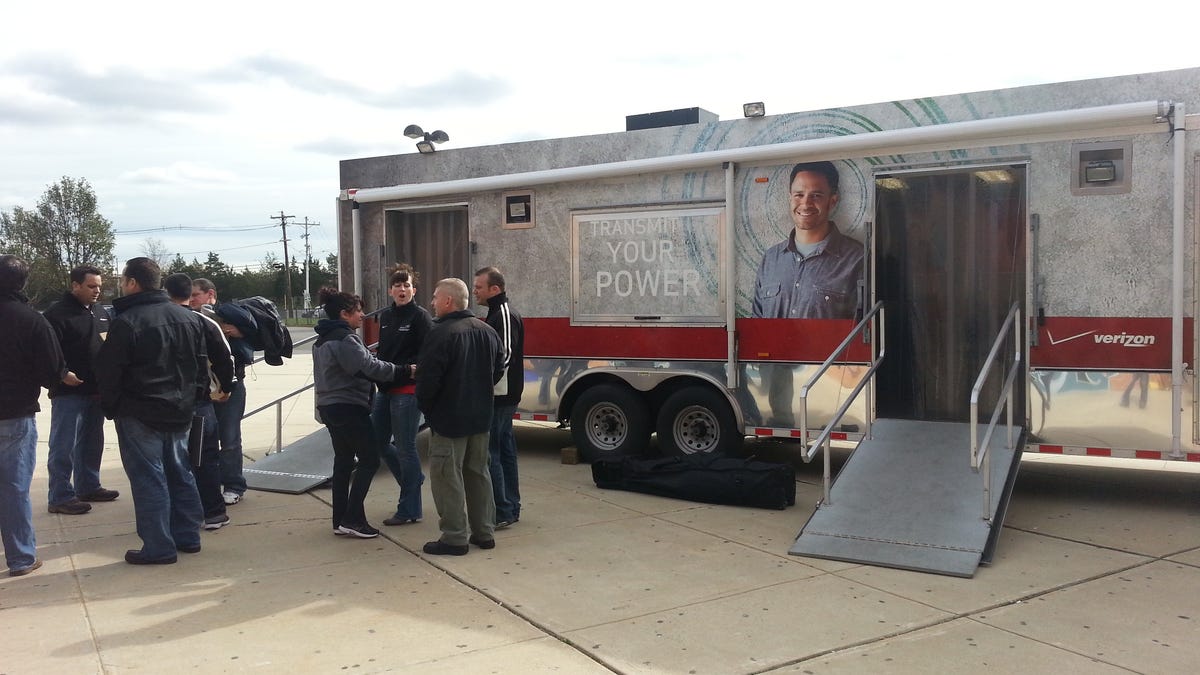How Verizon kept wireless service going after Sandy hit
CNET talks to one of the executives responsible for preparing for and dealing with a crisis. Verizon says 99 percent of its networks are back up, while AT&T is up to 98 percent.

With Hurricane Sandy due to hit the East Coast in a couple of days, Verizon Wireless executive Mike Haberman tested his house's back-up generator and ended up finding a faulty circuit that he quickly fixed. So when the outage hit his house in Morristown, N.J., he was able to get enough power to his laptop and phone to work from home last week.
That's a good thing, because Haberman was one of the key people coordinating the carrier's efforts to keep service going at a time when massive power outages wreaked havoc on the East Coast. Just as Haberman was able to stay connected to Verizon's 4G LTE network at home despite the lack of power, most customers affected by Sandy were able to make phone calls and browse the Internet on their smartphone, even if their home was dark.
Haberman's foresight in checking his home's generator is indicative of the planning Verizon did when preparing for Sandy, which explains why at its worst, only 6 percent of its cell sites were knocked out. At the same time, some of the other carriers had to play catch-up, with AT&T and T-Mobile striking a roaming agreement.
"We run to a crisis. When something hits, myself, other members of the team, we're singularly focused on that," Haberman said.
Haberman, Verizon's vice president of network support, told CNET today that 99 percent of its cellular sites were running, and coverage and signal strength were close to what they were prior to Hurricane Sandy.
In comparison, Sprint Nextel said today that 85 percent of its network in New York, New Jersey, and Connecticut were operational. AT&T said today that 98 percent of its affected cell sites were up, with nearly 95 percent working across New York City. T-Mobile said 95 percent of its sites in Manhattan were up, but service is still much worse in New Jersey, Long Island,and other parts of New York outside the metro area.
The speed in which the carriers have raced to fix the networks is indicative of how important a wireless connection, and what priority it is given at a time when power, heat, and transportation were all limited or gone.
With so many customers, even 1 percent represents a lot of people, and Haberman said that Jersey City, Hoboken, and Union County in New Jersey, and the central part of Long Island in New York continue to have problems.
Still, Verizon's network held up relatively well at a time when large swaths of New York, New Jersey, and Connecticut were without power.
Haberman credits the effectiveness of the network to Verizon's big bet on generators. The company has a fairly large number of generators at cell sites and regularly tests them for effectiveness, even running cell sites with traffic on the generators to ensure they can handle the load.
"Just like you would run them in your house, we test and test them with a load," he said. "We believe we had better service than our competitors," he said.
At the low-point of the power outage, Verizon was running 1,500 generators, consuming about 100,000 gallons of fuel a day. Prior to the storm hitting, Verizon had lined up contracts with fuel suppliers in the south and brought up fuel to its staging areas in the north, allowing the generators to run even after getting gas became an issue in the area, with drivers lining up for hours at gas stations waiting to fill up.
While many carriers will employ back-up generators, many only have enough fuel for a few days, and it's tough for any to plan for power outages that in some areas have gone on for a week. Haberman said there are still hundreds of generators running cell sites now, as power continues to be an issue for many parts of New York, New Jersey, and Connecticut. Even at the lowest point, none of Verizon's generators ran out of fuel, Haberman said.
While the number of generators at each cell site is high, Verizon constantly tries to up that number to guard against situations such as Hurricane Sandy. But Haberman noted that landlords and cooperative boards don't like them because they make a lot of noise when running. Verizon hopes a disaster like this opens the door to more people allowing generators near their homes and buildings.
Like other carriers, Verizon has plenty of experience dealing with the aftermath of extreme weather given the number of times the south and Gulf Coast get hit by hurricanes. Haberman said the company applied the lessons learned to the Northeast.
That also meant dealing with an uptick in traffic. With other means of communication down, Haberman said he saw a rise in voice calls, text messages, and data as more people chose to work from their homes.
Haberman said his role is to provide support for the field technicians and ensure that every department has the right information to act, eliminating potential bottlenecks in the recovery process.
Haberman, who worked in the office, said his home still has no power, although his low-wattage generator has helped keep some lights on (he has to pick and choose what he can run because the generator has a peak of 3,000 watts, and only about 1,500 watts when run continuously).
"My street did get power back, but five houses didn't, and I'm one of them," he said. "I don't think I'm a priority."
Updated at 1:48 p.m. PT: to include updated stats from AT&T's restoration efforts.

